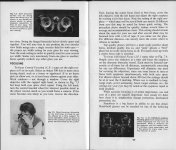BruceH
Avatar: Harris Hawk
Let’s assume the following:
This post is about the common center focus binocular that focuses both barrels simultaneously and has a separate diopter adjustment to make plus or minus adjustments to the right barrel. It can be either a roof or porro binocular.
Focus procedure:
1) Block the view of the right objective, then focus the left barrel using the center focus knob.
2) Block the view of the left objective, then focus the right barrel using the diopter adjustment. Do not change the center focus from the previous step and sight on the same object used to focus the left barrel.
- - - - - - - - - - - - - - - - - - - - -
Ever since I was very young, I have always initially set the focus/diopter setting using a distant object out at infinity. I have never given it much thought, I just did it that way.
I noticed that some instructions I have say choose a distant object, Zen-Ray says choose an object at least 75 feet away, and some instructions say choose an object with no mention of distance with the understanding I guess that it has to be at least past the close focus distance.
There are some issues from a practical stand point when using an object at infinity for initial setup. It can be difficult to find a target that provides good contrast and a sharp edge. Another issue is distortion from heat waves.
I was also thinking depth of field could possibly come into play. The far object has a large depth of field and the close object has a short depth of field.
What are the technical reasons for choosing either a far target or a close target?
What are practical reasons for choosing either a far target or a close target?
Does it make any difference?
I am looking forward to hearing what others are doing and why!
This post is about the common center focus binocular that focuses both barrels simultaneously and has a separate diopter adjustment to make plus or minus adjustments to the right barrel. It can be either a roof or porro binocular.
Focus procedure:
1) Block the view of the right objective, then focus the left barrel using the center focus knob.
2) Block the view of the left objective, then focus the right barrel using the diopter adjustment. Do not change the center focus from the previous step and sight on the same object used to focus the left barrel.
- - - - - - - - - - - - - - - - - - - - -
Ever since I was very young, I have always initially set the focus/diopter setting using a distant object out at infinity. I have never given it much thought, I just did it that way.
I noticed that some instructions I have say choose a distant object, Zen-Ray says choose an object at least 75 feet away, and some instructions say choose an object with no mention of distance with the understanding I guess that it has to be at least past the close focus distance.
There are some issues from a practical stand point when using an object at infinity for initial setup. It can be difficult to find a target that provides good contrast and a sharp edge. Another issue is distortion from heat waves.
I was also thinking depth of field could possibly come into play. The far object has a large depth of field and the close object has a short depth of field.
What are the technical reasons for choosing either a far target or a close target?
What are practical reasons for choosing either a far target or a close target?
Does it make any difference?
I am looking forward to hearing what others are doing and why!





